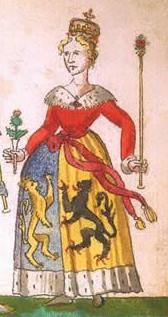|
Arnold Of Egmond
Arnold of Egmond (14 July 1410 – 23 February 1473) was Duke of Guelders, Count of Zutphen. Life Arnold was born in Egmond-Binnen, North Holland, the son of John II of Egmond and Maria van Arkel. On 11 July 1423, Arnold, still a boy, succeeded Duke Reinald IV. Arnold was the grandson of Reinald's sister, Johanna. Although the Emperor Sigismund had invested the Duke of Berg with the duchy of Gelders, Arnold retained the confidence of the Estates by enlarging their privileges, and enjoyed the support of Duke Philip of Burgundy. Arnold was betrothed, and afterwards united in marriage to Catherine of Cleves, a niece of Philip of Burgundy. Subsequently, however, Duke Arnold fell out with his ally as to the succession to the see of Utrecht, whereupon Philip joined with the four chief towns of Guelders in the successful attempt of Arnold's son Adolf to substitute his own for his father's authority. Arnold gave up his claim on Jülich only after his defeat in 1444 by Gerhard VII, ... [...More Info...] [...Related Items...] OR: [Wikipedia] [Google] [Baidu] |
House Of Egmont
The House of Egmond or Egmont (French: ''Maison d'Egmond'', Dutch: ''Huis Egmond'') is named after the Dutch town of Egmond, province of North Holland, and played an important role in the Netherlands during the Middle Ages and the Early modern period. The main lines ''Egmond-Geldern'' (Dukes of Geldern and Counts of Zutphen, extinct in 1538), ''Egmond-Gavere'' (Counts of Egmont, Princes of Gavere and Steenhuyze, extinct in 1682/1714) and ''Egmond-Buren-Leerdam'' (Counts of Buren and Leerdam, extinct in 1558) had high noble, princely rank. Besides the main and secondary lines that have died out, there were also some illegitimate lines of the family, including the ''Egmond van Merenstein'' (extinct in 1559), ''Egmond van Kenenburg'' (extinct in 1703), ''Egmond van de Nijenburg'' (Imperial Barons; extinct in 1747) and ''Egmond van Cranenburch''. Today there are still the extramarital lines of the Imperial Counts of ''Geldern-Egmond'' (today ''Mirbach-Geldern-Egmond'') and the ''Bar ... [...More Info...] [...Related Items...] OR: [Wikipedia] [Google] [Baidu] |
Roman Catholic Archdiocese Of Utrecht
The Archdiocese of Utrecht (; ) is an archdiocese of the Latin Church (or Western Church) of the Catholic Church in the Netherlands. The Archbishop of Utrecht is the metropolitan of the ecclesiastical province of Utrecht. There are six Suffragan bishop, suffragan dioceses of the province: Roman Catholic Diocese of Breda, Roman Catholic Dioceses of Breda, Roman Catholic Diocese of Groningen-Leeuwarden, of Groningen-Leeuwarden, Roman Catholic Diocese of Haarlem-Amsterdam, of Haarlem-Amsterdam, Roman Catholic Diocese of Roermond, of Roermond, Roman Catholic Diocese of Rotterdam, of Rotterdam, and Roman Catholic Diocese of 's-Hertogenbosch, of 's-Hertogenbosch. The cathedral church of the archdiocese is St Catherine's Cathedral, Utrecht, Saint Catherine's Cathedral, which replaced the prior cathedral, St. Martin's Cathedral, Utrecht, Saint Martin's Cathedral after it was taken by Protestants in the Reformation. History The diocese was founded in 695. In the Middle Ages, the bishops ... [...More Info...] [...Related Items...] OR: [Wikipedia] [Google] [Baidu] |
King Of Scots
The monarchy of the United Kingdom, commonly referred to as the British monarchy, is the form of government used by the United Kingdom by which a hereditary monarch reigns as the head of state, with their powers regulated by the British constitution. The term may also refer to the role of the royal family within the UK's broader political structure. The monarch since 8 September 2022 is King Charles III, who ascended the throne on the death of Queen Elizabeth II, his mother. The monarch and their immediate family undertake various official, ceremonial, diplomatic and representational duties. Although formally the monarch has authority over the governmentwhich is known as " His/Her Majesty's Government"this power may only be used according to laws enacted in Parliament and within constraints of convention and precedent. In practice the monarch's role, including that of Head of the Armed Forces, is limited to functions such as bestowing honours and appointing the prime mi ... [...More Info...] [...Related Items...] OR: [Wikipedia] [Google] [Baidu] |
James II Of Scotland
James II (16 October 1430 – 3 August 1460) was King of Scots from 1437 until his death in 1460. The eldest surviving son of James I of Scotland, he succeeded to the Scottish throne at the age of six, following the assassination of his father. The first Scottish monarch not to be crowned at Scone, James II's coronation took place at Holyrood Abbey in March 1437. After a reign characterised by struggles to maintain control of his kingdom, he was killed by an exploding cannon at Roxburgh Castle in 1460. Life James was born in Holyrood Abbey. He was the son of King James I and Joan Beaufort. By his first birthday, his only brother, his older twin, Alexander, had died, thus leaving James as heir apparent with the title Duke of Rothesay. On 21 February 1437, James I was assassinated, and the six-year-old James immediately succeeded him as James II. He was crowned in Holyrood Abbey by Abbot Patrick on 25 March 1437. On 3 July 1449, the eighteen-year-old James married t ... [...More Info...] [...Related Items...] OR: [Wikipedia] [Google] [Baidu] |
Marie Of Burgundy, Duchess Of Cleves
Mary of Burgundy, Duchess of Cleves (1393 – 30 October 1466) was the second child of John the Fearless and Margaret of Bavaria, and an elder sister of Philip the Good. Born in Dijon, she became the second wife of Adolph I, Duke of Cleves, Adolph, Count of Mark in May 1406. He was made the 1st Duke of Cleves in 1417. They were the grandparents of King Louis XII of France and the great-grandparents of John III, Duke of Cleves, father of Anne of Cleves, who was fourth Queen consort of Henry VIII of England. By their daughter, Catherine of Cleves (1417–1479), Catherine, they were ancestors of Mary, Queen of Scots. The Duke and Duchess of Cleves lived at Wijnendale Castle in West Flanders. She died in Duchy of Cleves, Cleves in present-day Monterberg, Kalkar. Influence At the death of Adolph I, Duke of Cleves, Adolph of Cleves in 1448, his son John I, Duke of Cleves, John I of Cleves succeeded him. Mary retired to , near Kalkar. Returning from a trip to the Middle East in 1449, Jo ... [...More Info...] [...Related Items...] OR: [Wikipedia] [Google] [Baidu] |
Adolph IV, Duke Of Cleves
Adolf (also spelt Adolph or Adolphe, Adolfo, and when Latinised Adolphus) is a given name with German origins. The name is a compound derived from the Old High German ''Athalwolf'' (or ''Hadulf''), a composition of ''athal'', or ''adal'', meaning "noble" (or '' had(u)''-, meaning "battle, combat"), and ''wolf''. The name is cognate to the Anglo-Saxon name '' Æthelwulf'' (also Eadulf or Eadwulf). The name can also be derived from the ancient Germanic elements "Wald" meaning "power", "brightness" and wolf (Waldwulf). Due to its extremely negative associations with the Nazi leader Adolf Hitler, the name has greatly declined in popularity since the end of World War II. Similar names include Lithuanian Adolfas and Latvian Ādolfs. The female forms Adolphine and Adolpha are far more rare than the male names. Adolphus can also appear as a surname, as in John Adolphus, the English historian. Popularity and usage During the 19th and early 20th centuries, Adolf was a popular name f ... [...More Info...] [...Related Items...] OR: [Wikipedia] [Google] [Baidu] |
Cleves
Kleve (; traditional ; ; ; ; ; Low Rhenish: ''Kleff'') is a town in the Lower Rhine region of northwestern Germany near the Dutch border and the River Rhine. From the 11th century onwards, Cleves was capital of a county and later a duchy. Today, Cleves is the capital of the district of Kleve in the German state of North Rhine-Westphalia. The city is home to one of the campuses of the Rhine-Waal University of Applied Sciences. Territory of the municipality In addition to the inner city, the territory of Kleve comprises fourteen villages and populated places: Bimmen, Brienen, Donsbrüggen, Düffelward, Griethausen, Keeken, Kellen, Materborn, Reichswalde, Rindern, Salmorth, Schenkenschanz, Warbeyen and Wardhausen. History The name ''Kleff'' probably derives from Middle Dutch ''clef'', ''clif'' 'cliff, bluff', referring to the promontory on which the Schwanenburg castle was constructed. Since the city's coat of arms displays three clover leaves (German ''Klee'', Lo ... [...More Info...] [...Related Items...] OR: [Wikipedia] [Google] [Baidu] |
Guelders Wars
The Guelders Wars (, German: ''Geldrische Erbfolgekriege'') were a series of conflicts in the Low Countries between the Duke of Burgundy, who controlled Holland, Flanders, Brabant, and Hainaut on the one side, and Charles, Duke of Guelders, who controlled Guelders, Groningen, and Frisia on the other side. The wars lasted from 1502 till 1543 and ended with a Burgundian victory. With this outcome, all of the Low Countries were now under the control of Charles V, Holy Roman Emperor. The conflicts were characterised by the absence of large battles between the armies of both parties. Instead small hit and run actions, raids, and ambushes were common practices. Regardless, the impact on civilians was large with hostilities and incidents occurring throughout the Low Countries. The wars included the sack of The Hague in 1528 and the failed siege of Antwerp in 1542 under the command of the Guelderian field marshal Maarten van Rossum. The war ended with the total destruction and deat ... [...More Info...] [...Related Items...] OR: [Wikipedia] [Google] [Baidu] |
Duke Of Burgundy
Duke of Burgundy () was a title used by the rulers of the Duchy of Burgundy, from its establishment in 843 to its annexation by the Crown lands of France, French crown in 1477, and later by members of the House of Habsburg, including Holy Roman Emperors and kings of Spain, who claimed Burgundy proper and ruled the Burgundian Netherlands. The Duchy of Burgundy was a small portion of the traditional lands of the Burgundians west of the river Saône which, in 843, was allotted to Charles the Bald's kingdom of the West Franks. Under the Ancien Régime, the duke of Burgundy was the premier lay Peerage of France, peer of the Kingdom of France. Beginning with Robert II of France (), the title was held by the Capetians, the French royal family. In 1032 King Henry I of France granted the duchy to his younger brother, Robert I, Duke of Burgundy, Robert, who founded the House of Burgundy. When the senior line of the House of Burgundy became extinct in 1361, the title was inherited by King Jo ... [...More Info...] [...Related Items...] OR: [Wikipedia] [Google] [Baidu] |
Charles The Bold
Charles Martin (10 November 1433 – 5 January 1477), called the Bold, was the last duke of Burgundy from the House of Valois-Burgundy, ruling from 1467 to 1477. He was the only surviving legitimate son of Philip the Good and his third wife, Isabella of Portugal. As heir and as ruler, Charles vied for power and influence with rivals such as his overlord, King Louis XI of France. In 1465 Charles led a successful revolt of Louis's vassals in the War of the Public Weal. After becoming the Duke of Burgundy in 1467, Charles pursued his ambitions for a kingdom, independent from France, that would stretch contiguously from the North Sea in the north to the borders of Savoy in the south. For this purpose, he acquired Guelders and Upper Alsace; sought the title King of the Romans; and gradually became an enemy of the Germans. Charles married Margaret of York for an English alliance. He arranged the betrothal between his sole child, Mary, with Maximilian of Austria. A passiona ... [...More Info...] [...Related Items...] OR: [Wikipedia] [Google] [Baidu] |




